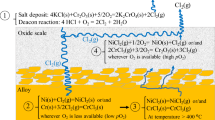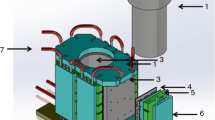Abstract
Methods of testing refractory and barrier (shielding) materials used in the lining of aluminum electrolyzers for resistance against corrosive attack of electrolyte components are briefly reviewed. The advantages of a method proposed by Allaire et al. [2] are emphasized vis-a-vis the conventional methods that are used to simulate performance of the aluminum electrolysis cell.
Similar content being viewed by others
REFERENCES
F. J. Stig and K. Signe, “Penetration force of bath components into pot linings described by nonequilibrium thermodynamics,” Light Met., 287–294 (1997).
C. Allaire, R. Pelletier, O.-J. Siljan, and A. Tabereaux, “An improved corrosion test for potlining refractories,” Light Met., 245–249 (2001).
F. Brunk, W. Becker, and K. Lepere, “Cryolite influence on refractory bricks. Influence of SiO2 content and furnace atmosphere,” Light Met., 315–320 (1993).
S. F. Johanson, “An alternative method for evaluation of resistance of pot insulation to bath attack,” Light Met., 501–514 (1986).
R. P. Pawlek, “Methods to test refractories against bath attack in aluminium electrolysis pots,” Aluminium, 70(9/10), 555–559 (1994).
S. Huwyler and W. Schmidt-Hatting, Process for Testing Nonoxidizable Insulating Lining Materials for Aluminium Electrolysis Units for Cryolite Resistance, DE 2133847, priority date 17.7.1970, Schweizeirische Aluminium AG.
R. Pawlek, “Refractory materials for aluminium electrolysis,” Interceram., 25(1), 25–26 (1976).
A. T. Tabereaux, “Thermal insulation method for reduction cell cathodes,” Light Met., 571–593 (1982).
“Anon. Dencast 50, a new refractory castable for the aluminium industry,” Aluminium, 63(6), 574–575 (1987).
E. Olsen and U. Randas, “A refractory castable for potline and casthouse,” Aluminium, 63(9), 879–880 (1987).
Y. Guangchun, Z. Wangxi, and Q. Zhuxian, “On the MgO-C composite refractory diffusion barrier in alumina reduction cell cathodes,” Light Met., 349–351 (1993).
R. Feuge and H. J. Balk, “Cryolite stability of fireclay lining material for aluminium electrolysis cells (Feuerfest Baust. Metall. Nichteisenmet.)”, in: Int. Feuerfest-Kolloq. 23rd (1980), pp. 334–343.
D. V. Steward and A. T. Tabereaux, “Refractory castable for alumina reduction cells,” Ceram. Eng. Sci. Proc., 9(1/2), 39–42 (1998).
D. V. Steward and A. T. Tabereaux, “Evaluation of castable refractory barriers reduction cell cathodes,” Light Met., 153–160 (1989).
L. C. Edwards and C. L. Crozier, “Evaluation of a bauxite lowcement castable in aluminium smelting applications,” Light Met., 407–412 (1992).
G. Oprea, “Wettability and reactivity of silica-alumina refractories in contact with cryolitic bath,” in: Aluminium of Sibiria (1996), pp. 106–131.
D. Harris and G. Oprea, “Cryolite penetration studies on barrier refractories for aluminium electrolytic cells,” Light Met., 419–427 (2000).
G. R. Peltier, “Evaluation of a spray on barrier for reduction cell cathode,” Light Met., 413–418 (1991).
G. Oprea, “Standard test method for corrosion resistance of refractories to molten cryolitic bath,” in: Task Force Meeting of ASTM Subcommittee C8.05 Refractories for Aluminum Industry, San Antonio, TX (1998).
Standard ISO_DIS 5022 cf PRE_R7.
Cryolite test SINTEF_ALILAB, Division of Metallurgy, 7034 Trondheim, Norway.
V. V. Slavin, “Schungites used as lining materials for aluminium electrolyzers,” Tsvetn. Met., No. 2, 32–34 (1985)
C. Allaire, “Electrolysis bath testing of refractories at ALCAN,” J. Can. Ceram. Soc., 60(2), 47–52 (1991).
C. Alliare, “Refractory lining for alumina reduction cell,” J. Am. Ceram. Soc., 75(8), 2308–2311 (1992).
P. Homsi, “Cathode design, materials selection and performance for long life,” in: 4th Australian Aluminium Smelter Technology Workshop, Sydney, Australia, 25-30 Oct. (1992), pp. 548–595.
G. V. Solonin, M. A. Fridman, and V. K. Nikitenko, “Use of ceramic material for filling joints in cell cathode blocks,” Light Met., 419–424 (2002).
O.-J. Siljan, Ch. Schoning, and T. Grande “State-of-the-art alumino-silicate refractories for Al electrolysis cells,” JOM, 46–63 (2002).
O.-J. Siljan, T. Grande, and Ch. Schoning, “Refractories for aluminium electrolysis cells. Part IV: Comparison of laboratory investigations and autopsies of pot linings,” Aluminium, 77, 809–814 (2001).
Author information
Authors and Affiliations
Rights and permissions
About this article
Cite this article
Simakov, D.A., Proshkin, A.V. & Polyakov, P.V. Tests for Resistance to Cryolite: Methods and Comparative Evaluation. Refractories and Industrial Ceramics 45, 190–195 (2004). https://doi.org/10.1023/B:REFR.0000036728.31305.55
Issue Date:
DOI: https://doi.org/10.1023/B:REFR.0000036728.31305.55




